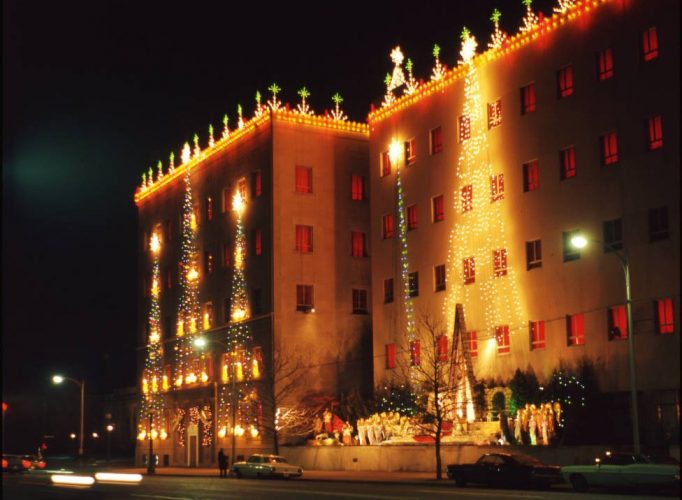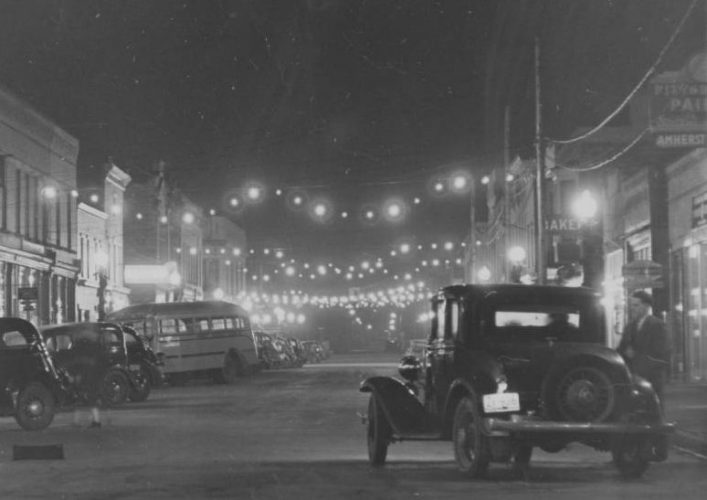The Cold of Winter: Winter Solstice

State Auto Insurance Company’s holiday display in Columbus, December 1969. Via Ohio Memory.
“What good is the warmth of summer, without the cold of winter to give it sweetness.”
John Steinbeck
On December 21, 2018, at 5:23 p.m. Eastern Standard Time, the North Pole will be at its furthest point from the sun and, at that moment, the winter solstice will occur. Here in Ohio, we will observe just under nine hours of daylight, about 60% of the number of hours we’ll see at the summer solstice in six months. As we observe the solstice, we’ll join millions of others around the world who have also observed the first day of the astronomical winter for millennia.

The word “solstice” has its roots in Latin: sol meaning “sun” and sistere meaning “to stand still.” On this day the sun reaches its southernmost point and then appears to stand still as it begins its return northward. This brief appearance of the sun is associated with death and rebirth; across cultures, it has signified the death of the old sun and the birth of the new and has prompted celebrations that last for days or weeks.
Rome’s Saturnalia, for example, lasted for seven days and was characterized by a sense of good will towards others: grudges were forgiven, reunions were held, and gifts were exchanged. Saturnalia was also exemplified by indulgence and enjoyment, something we continue to celebrate during the Christmas holidays. Fudge and eggnog and Christmas parties, anyone?
Another common characteristic of winter solstice observances is that of lighting the darkness. The Welsh celebration Alban Arthan literally means “light of winter,” and signifies the defeat of the Holly King, whose rule begins at the summer solstice, by the Oak King, who is represented by the new sun. From Alban Arthan we get the tradition of hanging mistletoe, which has green foliage even in winter, proving that life continues to thrive even during the coldest, darkest days; evergreen boughs similarly represent life, making them a common adornment of our homes during the winter. Alban Arthan originated with Celtic pagan cultures but it is still observed by modern Druids.

Similar to Alban Arthan is Yule, which is also celebrated at the winter solstice but is likely far more familiar, at least in terms of its name, which is frequently used to describe the winter holiday season and appears in numerous Christmas songs. Yule has also contributed traditions to the Christmas holiday, most notably the burning of the Yule log. This Kent Tribune article, near the center of page 12 from the paper’s December 10, 1925, issue, describes the practice simply: “The Yule log is thought to bring good fortune, and frequently part of it is saved to light the new one in the following year…. ’Yule’ is an old word for Christmas, and is still so used provincially.” If you don’t choose to burn a Yule log, however, maybe you would rather eat one! The Sun, published in North Canton, shared a recipe for a Bûche de Noël on December 25, 1985 (at right, or click the link to view the recipe and instructions). A traditional Christmas cake, the Bûche de Noël is rolled to resemble a log and is often decorated with chocolate shavings and meringue mushrooms.
Here in Ohio, ancient cultures have also observed the movement of the sun, and the winter solstice is no exception. The Great Serpent Mound in Adams County is an effigy that was likely built by the Fort Ancient people nearly 1,000 years ago. The serpent aligns to the sun on significant days, such as the winter solstice, when the tail points to the rising sun, and on the summer solstice, when the head points to the setting sun.
No examination of the winter solstice would be complete without a discussion of lights. Two years ago, Ohio Memory published a blog post that discussed the role of lights in the observations and celebrations of both Hanukkah and Christmas; you can read that blog post here. The practice of using light at Christmas is, to be sure, far more closely related to Paganism than is Hanukkah, but light, for both, symbolizes hope and strength in the face of adversity, whether that adversity comes in the form of rebellion and uprising, or from the deepening darkness.
Tonight, when the sun goes down, it will be the earliest sunset of the year; tomorrow, the sun will brighten our world for a little bit longer. Meanwhile, light a candle, turn on your holiday lights, or just pause and reflect on the sun and its light and warmth. And remember, if there were no darkness, we couldn’t see the light.
Happy holidays from Ohio Memory!
Thank you to Shannon Kupfer-Trausch, Digital Initiatives Librarian at the State Library of Ohio, for this week’s post!



Leave a Reply
You must be logged in to post a comment.